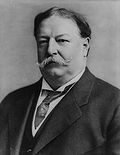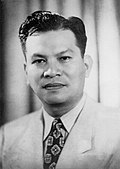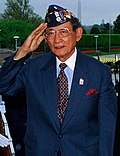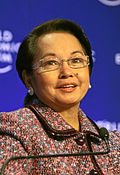| History of the Philippines |
|---|
 |
| Timeline |
| Maginoo , Wangs, Rajahs, Lakans, Datus and Sultans of the Philippines | |
|---|---|
 A couple belonging in the maginoo (noble class) | |
| Details | |
| Style | Maginoo Kamahalan Kapunuan |
| First monarch | Jayadewa (and other various rulers from the archipelago) |
| Last monarch | Mohammed Mahakuttah Abdullah Kiram (and other various rulers from the archipelago) |
| Formation | c. 900 (according to LCI) |
| Residence | Torogan (Maranao, Langgal (Bangsamoro area) Bahay kubo |
The types of sovereign state leaders in the Philippines have varied throughout the country's history, from heads of ancient chiefdoms, kingdoms and sultanates in the pre-colonial period, to the leaders of Spanish, American, and Japanese colonial governments as well as an unrecognized independent government, and the directly elected president of the modern sovereign state of the Philippines.
Contents
- Archaic (pre-hispanic) Era
- Legendary rulers
- Archaic rulers
- Recorded rulers of Namayan
- The datus of Madja-as
- Philippines Era
- Rulers during the Spanish colonization
- During Revolts against Spain (1660–1661)
- British Occupation of Manila (1762–1764)
- Independent Ilocos (1762–1763)
- Under New Spain (1764–1821)
- Emperor of the Philippine Islands
- Spanish East Indies (1821–1898)
- Revolutionary Republics and States
- Sovereign Nation of the Tagalog People (1896–1897)
- Republic of Biak-na-Bato (1897)
- Central Executive Committee and the Dictatorial Government of the Philippines (1898)
- Negros Republic (1898–1901)
- Federal State of the Visayas (1898–1899)
- First Philippine Republic (1899–1902)
- Republic of Zamboanga (1899–1903)
- Republic of the Tagalog Nation (1902–1906)
- American Colonial Period
- Military Government of the Philippine Islands (1898–1902)
- Insular Government of the Philippine Islands (1902–1935)
- Commonwealth of the Philippines (1935–1946)
- World War II
- Japanese occupation of the Philippines
- Philippine Executive Commission (1942–1943)
- Second Philippine Republic (1943–1945)
- Republic of the Philippines
- Third Philippine Republic (1946–1973)
- Martial law and the Fourth Philippine Republic (1973–1986)
- Provisional Government (1986–1987)
- Fifth Philippine Republic (1987–Present)
- See also
- Notes
- Subnotes
- References
- Works cited
- External links














































































